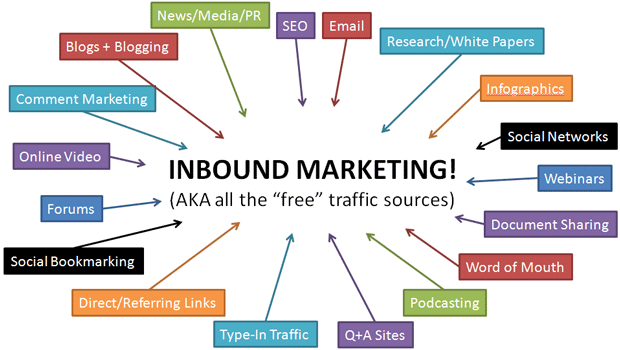There’s been a lot of kerfuffle in the industry in the last year or two over whether or not we should still call what we do “SEO” A lot of people (myself included) have settled on the term inbound marketing as a useful catch-all way to talk about the increasingly diverse set of tactics web marketers are using to bring customers to their sites. Rand Fishkin made a handy, only slightly overwhelming little graphic about it:
From Inbound Marketing is Taking Off by Rand Fishkin
Why not just SEO?
One of the main arguments I’ve heard against calling it inbound marketing (other than people who just plain don’t like the term) is that SEO is already a thing. If we’re still spending our time optimizing a website for maximum organic traffic from search engines, why do we need a new term?
For many of us, SEO is an important part of what we do nowadays but it’s still only part of what we’re tasked with. A modern website marketer’s main task is far more likely to be “drive as much traffic to the website as possible from non-advertising sources, then get that traffic to convert better” than it is specifically “get more and better traffic from search engines.” Some of us are lucky enough to work on teams of people getting the dizzying array of inbound marketing tasks done; for many web marketers, it’s all up to us.
Where the Boys (and Girls) Are
When I started doing SEO, the main three sources of unpaid traffic were organic search, direct traffic, and referrals. Then social media became a bigger and bigger source of traffic, until it no longer really made sense to treat it as referral traffic. Now all kinds of websites are adding a social element to capture people’s interests, eyeballs and dollars. Sites like Facebook and Twitter, as well as more niche offerings like Pinterest and Instagram, are providing whole platforms for users to consume content – all without visiting search engines or your website.
How big a deal is this? According to ComScore, Facebook has the 4th highest uniques in the U.S. – and is the number one non-search-engine property. Facebook is also second only to YouTube in online video content viewing. Pinterest has over 10 million users. Instagram has over 30 million.
We need to expand beyond search engine optimization because search engines aren’t the only way people discover or consume content anymore.
For informational queries (where is it, what is it, where can I buy one, what’s that movie where John Candy eats the giant steak) search engines may still reign supreme. But social content portals provide a huge benefit for top-of-funnel marketing: getting your products/services/content in front of users who don’t already know about them. Your content and brand is now discoverable and consumable on social platforms, which means having an online marketing strategy that includes content on 3rd-party sites is more and more crucial.
Inbound Marketing is Good for SEO
Online branding is of increased importance in SEO, too. We’ve all seen Google playing with making brands more important in SERPs by showing multiple results for one site for some queries. The rise of personalized search means that engaging users on social platforms increases the likelihood that you’ll show up in their/their friends’ SERPs, too. Expanding our digital marketing efforts to include building brand awareness on third-party sites is a rising tide that raises all boats.
The Next Steps
Content marketing is, of course, a huge part of SEO and of inbound marketing. As online marketers, we need to start thinking about content consumption on third-party sites and working it in to our existing content marketing strategies. This includes:
- Adding relevant sharing buttons to our on-site content
- Creating unique content for different channels, such as separate videos for Google+ and for YouTube or creating unique images we only share on Pinterest
- Treating relevant content-sharing networks as new social media platforms and building a presence to engage users directly on them
- Instituting brand monitoring and sentiment analysis to track our branding efforts off-site
It’s a bold new world out there. I, for one, am excited at the prospect of inbound channels that don’t rhyme with “moogle.”



